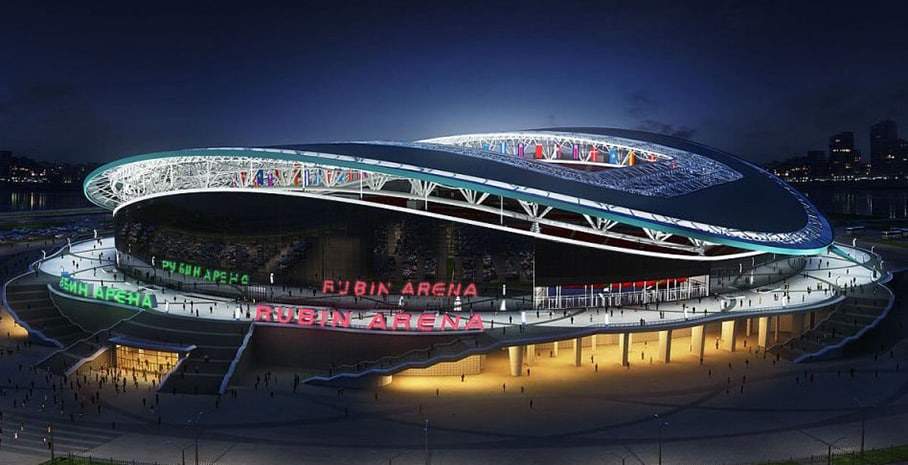3000 kilometers from Kaliningrad to Ekaterinburg. That’s what it means to organize a World Cup in the largest country in the world. Russia invested a lot of money to become the first Eastern European country to host the most prestigious sports event. Let’s take a closer look at the 12 stadiums spread out in 11 cities across the European part of the Russian Federation.
Luzhniki Stadium (Moscow)
This is the stadium where Russia and Saudi Arabia will meet in the opening match on June 14 and where the finalists will face off on July 15. It has the most capacity out of all the World Cup stadiums with 81.000 seats available. Originally built in 1956, Luzhniki Stadium used to be known as Central Lenin Stadium. Since then, it has been revamped several times, most notably during the 1980 Summer Olympics in Moscow and for this World Cup. Luzhniki does not have a club associated with it. First and foremost, it is the national team’s venue of choice. A total of six World Cup matches will be played here, four in the group stage and three in the knockout rounds.
Ekaterinburg Arena (Ekaterinburg)
Also known as Central Stadium, Ekaterinburg Arena is the home of FK Ural Ekaterinburg. Located in Sverdlovskaya Oblast on the eastern side of the Ural Mountains, it is the easternmost World Cup host. For the purposes of this event, the arena was renovated and partially reconstructed. Two temporary stands were added to the north and south side, increasing the capacity from 26.000 to 35.000. Four group stage games will be played at Ekaterinburg Arena, the smallest World Cup 2018 venue.
Krestovsky Stadium (Saint Petersburg)
Also known as Zenit Arena, Krestovsky Stadium will be named Saint Petersburg Arena during the World Cup. It is the home of Zenit St. Petersburg, one of Russia’s most reputable clubs. Officially completed in 2017, it is one of the most expensive stadiums ever made (nearly €1 billion). The northernmost World Cup 2018 venue has a capacity of over 67.000 seats and will host a total of seven matches, including a semi-final and the third place play-off match.
Fisht Olympic Stadium (Sochi)
Constructed especially for the 2014 Winter Olympics, Fisht Stadium in Sochi is a modern stadium with a capacity for up to 48.000 spectators. In 2014, Sochi became the first ever warm weather city to host the Winter Olympics. This year, Fisht Stadium is the southernmost venue. Four matches in the group stage and two matches in the knockout phase will be played here.
Kazan Arena (Kazan)
Completed in 2013, Kazan Arena is the home of Rubin Kazan. Located in the Republic of Tatarstan, it is one of the most eye-catching World Cup venues with its enormous outdoor screen that’s considered to be the largest one in Europe. Kazan Arena will host a total of six World Cup contests, two of them in the knockout stage.
Spartak Stadium (Moscow)
Spartak Stadium or Otkritie Arena is the home of Spartak Moscow and the host of five World Cup matches. Like most of the other stadiums in Russia, it is brand new, having been completed in 2014. It holds a capacity of 45.000 viewers and is the only privately owned World Cup arena.
Mordovia Arena (Saransk)
Saransk isn’t the most obvious choice when you think of a Russian city that can welcome World Cup crowds. Having been selected as such, the 300.000 capital of Mordovia is the smallest World Cup 2018 host city. Its recently finished Mordovia Arena can receive up to 45.000 spectators and will welcome eight teams in four group stage matches.
Kaliningrad Stadium (Kaliningrad)
Kaliningrad is the second smallest World Cup 2018 host and the westernmost World Cup host. Much like Mordovia Arena, Kalinigrad Stadium was also completed late, a couple of months before kickoff. It has the same capacity of 45.000 seats and will welcome the same amount of matches (four). After the World Cup, the stadium’s capacity will be reduced and it will become the new home of FC Baltika.
Cosmos Arena (Samara)
Cosmos Arena was built especially for this World Cup. Samara’s new crown jewel will play host to six matches, four in the group stage, one in the Round of 16 and one in the quarter-finals. Starting next season, the 45.000 capacity venue will become FC Krylia Sovetov’s new home pitch. Samara is a city known for its space industry. That’s where the stadium got its name from.
Rostov Arena (Rostov-on-Don)
Rostov Arena has one of the most peculiar stories out of the World Cup stadiums. During the initial stages of construction, five World War II bomb shells were found, delaying the realization of the project. The arena was eventually completed in 2018. It will host five World Cup games. The arena’s 45.000 seats will be reduced to 25.000 after the event, while the arena itself will be FC Rostov’s new home.
Nizhny Novgorod Stadium (Nizhny Novgorod)
Nizhny Novgorod Stadium is built on a location where Volga, Europe’s longest river, and Oka meet. It is a beautiful stadium that has place for 45.000 visitors. Six games will be played here, two in the group stage and two in the knockout phase of the competition.
Volgograd Arena (Volgograd)
Last, but not least is Volgograd Arena, another brand new stadium that was finished days before the deadline. It was built on the same principle like the rest of them. It holds a capacity of 45.000 seats that will be reduced to 35.000 after the World Cup. Then, FC Rotor will be the team that will use Volgograd Arena for its home matches. The stadium will host four group stage fixtures.





